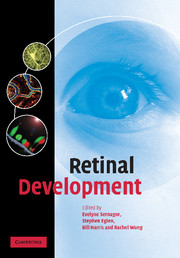Book contents
- Frontmatter
- Contents
- List of contributors
- Foreword
- Preface
- Acknowledgements
- 1 Introduction – from eye field to eyesight
- 2 Formation of the eye field
- 3 Retinal neurogenesis
- 4 Cell migration
- 5 Cell determination
- 6 Neurotransmitters and neurotrophins
- 7 Comparison of development of the primate fovea centralis with peripheral retina
- 8 Optic nerve formation
- 9 Glial cells in the developing retina
- 10 Retinal mosaics
- 11 Programmed cell death
- 12 Dendritic growth
- 13 Synaptogenesis and early neural activity
- 14 Emergence of light responses
- New perspectives
- 15 Regeneration: transdifferentiation and stem cells
- 16 Genomics
- 17 Zebrafish models of retinal development and disease
- Index
- Plate section
- References
17 - Zebrafish models of retinal development and disease
Published online by Cambridge University Press: 22 August 2009
- Frontmatter
- Contents
- List of contributors
- Foreword
- Preface
- Acknowledgements
- 1 Introduction – from eye field to eyesight
- 2 Formation of the eye field
- 3 Retinal neurogenesis
- 4 Cell migration
- 5 Cell determination
- 6 Neurotransmitters and neurotrophins
- 7 Comparison of development of the primate fovea centralis with peripheral retina
- 8 Optic nerve formation
- 9 Glial cells in the developing retina
- 10 Retinal mosaics
- 11 Programmed cell death
- 12 Dendritic growth
- 13 Synaptogenesis and early neural activity
- 14 Emergence of light responses
- New perspectives
- 15 Regeneration: transdifferentiation and stem cells
- 16 Genomics
- 17 Zebrafish models of retinal development and disease
- Index
- Plate section
- References
Summary
Introduction
The zebrafish (Danio rerio; Brachydanio rerio in older literature) has become a powerful model system to study genetic mechanisms of vertebrate development and disease. Much of the current success can be traced back to the pioneering work of George Streisinger and colleagues at the University of Oregon. Like many of his peers, Streisinger had an acclaimed research programme on phage genetics but sought a eukaryotic system to expand further the known roles of genes in biological processes. Whereas Seymour Benzer focused his efforts on Drosophila and Sydney Brenner (Brenner, 1974) adopted the nematode worm, Streisinger, a fish hobbiest, turned his efforts towards the zebrafish (Streisinger et al., 1981; Chakrabarti et al., 1983; Walker and Streisinger, 1983; Grunwald and Streisinger, 1992). Streisinger first recognized many of the oft-cited advantages for the use of zebrafish as a genetic model (Mullins and Nusslein-Volhard, 1993; Driever et al., 1994; Solnica-Krezel et al., 1994). Zebrafish, small freshwater teleosts, are easily adapted to the laboratory setting and can be maintained in a relatively small space. The fish typically reach sexual maturity in 3 to 4 months, and a breeding pair of fish can produce >200 fertilized eggs per mating. Fertilization is external, and the egg and embryo are transparent, facilitating visual identification of morphogenetic movements and organogenesis with a standard dissecting microscope. Development is rapid; by 24 hours post-fertilization (hpf) all of the major organ systems have formed and spontaneous muscle flexures soon begin.
- Type
- Chapter
- Information
- Retinal Development , pp. 342 - 370Publisher: Cambridge University PressPrint publication year: 2006



